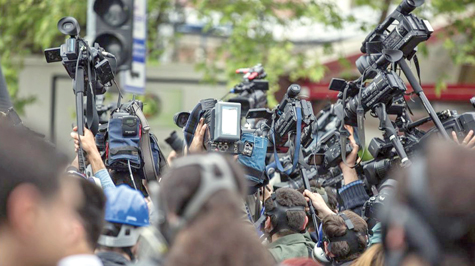 Around three decades ago, I attended a journalism training course at Reuters in London and the first thing they taught us was that “no story is worth your life”. In other words, as a reporter, if you think that your life is in danger, just make a tactical withdrawal. It does not even have to be a battlefield per se – though a lot of journalists have died both in Gaza and in Ukraine, the two major current theatres of war.
Around three decades ago, I attended a journalism training course at Reuters in London and the first thing they taught us was that “no story is worth your life”. In other words, as a reporter, if you think that your life is in danger, just make a tactical withdrawal. It does not even have to be a battlefield per se – though a lot of journalists have died both in Gaza and in Ukraine, the two major current theatres of war.
Journalists who report on wars and conflicts are sometimes targeted even when they are wearing a clear “Press” badge. This is exactly what happened when Israeli Defence Forces (IDF) gunned down Palestinian Al Jazeera journalist Shireen Abu Akleh on May 12, 2022.
However, many investigative journalists who have never set foot on the frontlines have suffered the wrath of unseen forces. Journalism is a risky profession, whichever way you look at it. All you have to do is write something that irks someone with power or influence and your life could be at risk.
There is another dimension to this saga. We have all heard the expression “shooting the messenger”. A journalist is only a messenger who tells the truth to the world. But some think that just shooting the messenger (literally) will cover up whatever the journalist was reporting on.
Either way, it is only rarely that those who commit crimes against journalists are caught and brought to justice. This impunity is a worldwide problem, that even includes many developed countries. Former US President Donald Trump, who may get another stint at the White House from next year, has even called journalists “enemies of the people”. Many leaders around the world share the same view, though not many of them will say it openly. There is a tendency to view the press and hence the journalists as a threat.
Attacks on journalists
Here in Sri Lanka too, there were several killings and disappearances of journalists, apart from physical assaults, which have not been resolved up to date. Examples include the killing of Sunday Leader Editor Lasantha Wicrematunga, the disappearance of cartoonist Prageeth Ekneligoda and the assault on Sunday Times journalist Keith Nohayr. The Government that will be elected on November 14 must undertake new and complete investigations on all these cases.
Ending impunity for crimes against journalists is one of the most important and complex challenges of recent times. After all, it is an essential precondition to guarantee freedom of expression and access to information for all citizens.
 In this context, the United Nations (UN) has declared November 2 as the International Day to End Impunity for Crimes against Journalists. This also covers other media workers. The United Nations General Assembly proclaimed 2 November as the ‘International Day to End Impunity for Crimes against Journalists’ in General Assembly Resolution A/RES/68/163. The Resolution urged Member States to implement definite measures countering the present culture of impunity. The date was chosen in commemoration of the assassination of two French journalists in Mali on November 2, 2013.
In this context, the United Nations (UN) has declared November 2 as the International Day to End Impunity for Crimes against Journalists. This also covers other media workers. The United Nations General Assembly proclaimed 2 November as the ‘International Day to End Impunity for Crimes against Journalists’ in General Assembly Resolution A/RES/68/163. The Resolution urged Member States to implement definite measures countering the present culture of impunity. The date was chosen in commemoration of the assassination of two French journalists in Mali on November 2, 2013.
The event in this connection will take place on November 6 and 7 at at the African Union (AU) Headquarters in Addis Ababa, Ethiopia under the theme of Safety of Journalists in Crises and Emergencies. This is an apt theme, given the wars and crises in Gaza, Ukraine, Sudan, Ethiopia, Yemen and many other countries and regions.
With the rise of conflicts and other crises, the 2024 observance seeks to promote a broader discussion on the safety of journalists working in these contexts, including the prevention, protection and prosecution concerns of journalists affected by such challenges.
In the words of the UN, “many journalists, media professionals, and associated media personnel exercise their duties in highly dangerous contexts. Too many pay an unacceptably high price, including death, enforced disappearance, torture, unlawful detention, and kidnapping, for producing independent, reliable, and verifiable information”.
Journalists reporting from crisis- and conflict-zones face severe threats in carrying out their critical work. While from 2017 UNESCO recorded gradual decreases in media workers killed in conflict zones, more recently the trend has been reversed. UNESCO’s monitoring in 2023 recorded that more than 50 percent of journalist killings occurred in crisis- and conflict-zones, with continuously high numbers in the first half of 2024.
Tragedies, tip of the iceberg
These tragedies are only the tip of the iceberg. Media infrastructure is often damaged or destroyed, and journalists face physical attacks, detention, equipment confiscation or denial of access to reporting sites. Many are forced to flee or cease their work, risking turning conflict areas into “zones of silence”.
Whether reporting on conflict, humanitarian disasters, climate or health crises, journalists continue to face disproportionate threats and higher levels of impunity for extrajudicial killings, torture, enforced disappearances and arbitrary detention, as well as intimidation and harassment, both offline and online. Women journalists are especially targeted for online harassment. According to UNESCO’s discussion paper, “The Chilling: Global Trends in Online Violence against Women Journalists”, 73 percent of the women journalists surveyed said they had been threatened, intimidated and insulted online in connection with their work. In 2021, the percentage of women among all journalists killed almost doubled, rising to 11 percent from 6 percent the previous year.
Governments, terror groups, business cartels, crime gangs and other groups with vested interests may engage in such practices to silence journalists whose reporting could threaten their existence. In many cases, threats of violence and attacks against journalists are not properly investigated. This impunity emboldens the perpetrators of the crimes and at the same time has a chilling effect on society, including journalists and media outlets themselves.
Latin America and the Caribbean continue to be the region with the highest number of murders of journalists, according to a recent UNESCO Report. Around the world, 153 journalists were killed in the line of duty in 2022-2023 and 117 journalists were killed in 2020-2021. In 2020 and 2021, Latin America and the Caribbean accounted for 38 percent of killings, followed by Asia and the Pacific with 32 percent of killings. Only 14 percent of cases of crimes against journalists are currently considered judicially resolved worldwide.
Since 1993, more than 1,700 journalists have been killed for reporting the news and bringing information to the public. In nine out of ten cases the killers go unpunished, according to the UNESCO Observatory of Killed Journalists. Impunity leads to more killings and is often a symptom of worsening conflict and the breakdown of law and judicial systems.
Issue of Impunity
Incidentally, the UN Plan of Action on the Safety of Journalists and the Issue of Impunity is the first concerted effort within the UN to address attacks and impunity of crimes against journalists, with a multi-stakeholder and holistic approach. It brings together UN bodies, national authorities, media, and civil society organisations.
Journalists and media houses cannot afford to hire bodyguards or deploy other methods to protect themselves – Governments and media regulatory authorities worldwide must ensure a safe environment for journalists to work without fear and also end the impunity for crimes committed against journalists.
These journalists who laid down their lives to tell the truth will never come back, but taking these steps will at least ensure their legacy and a worry-free environment for their colleagues to carry on their critical mission.









